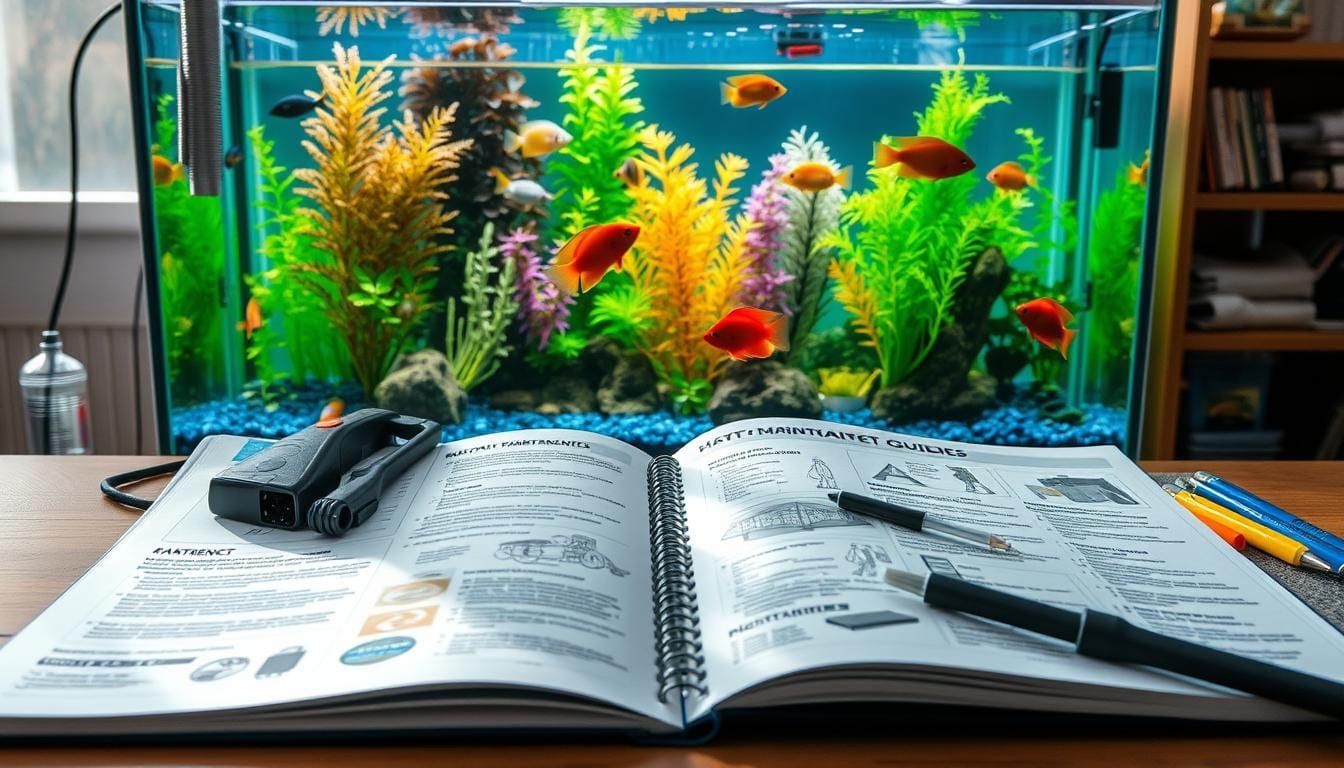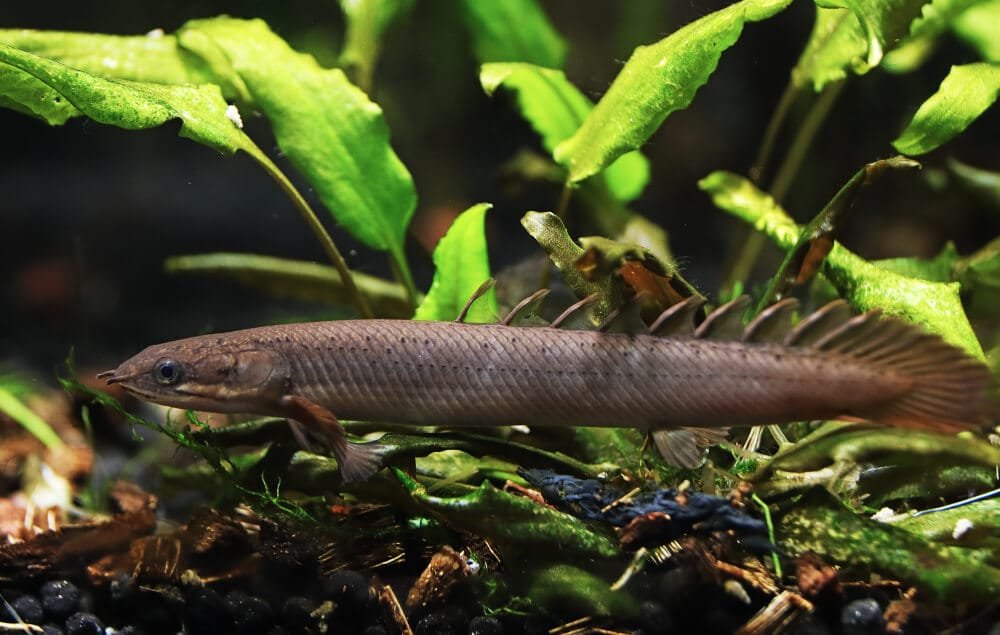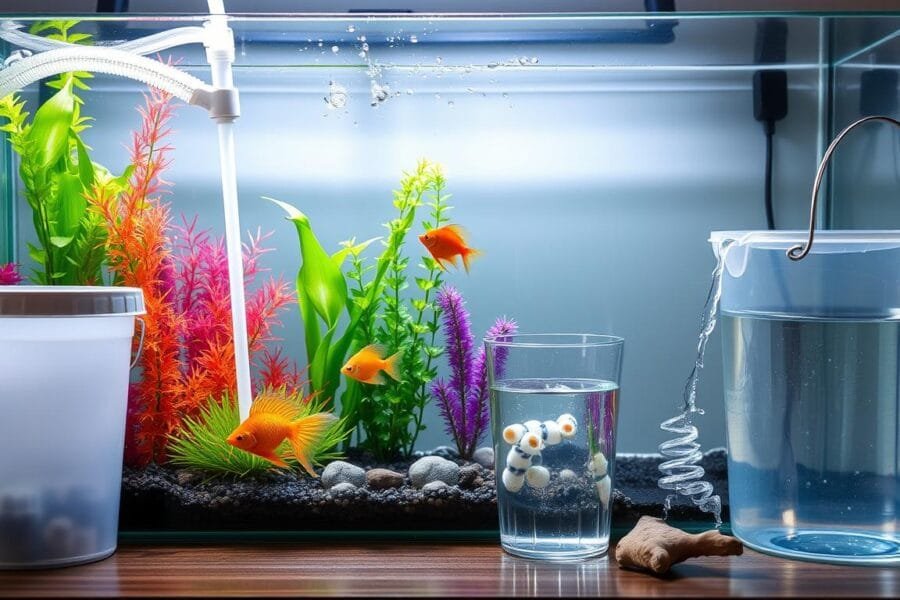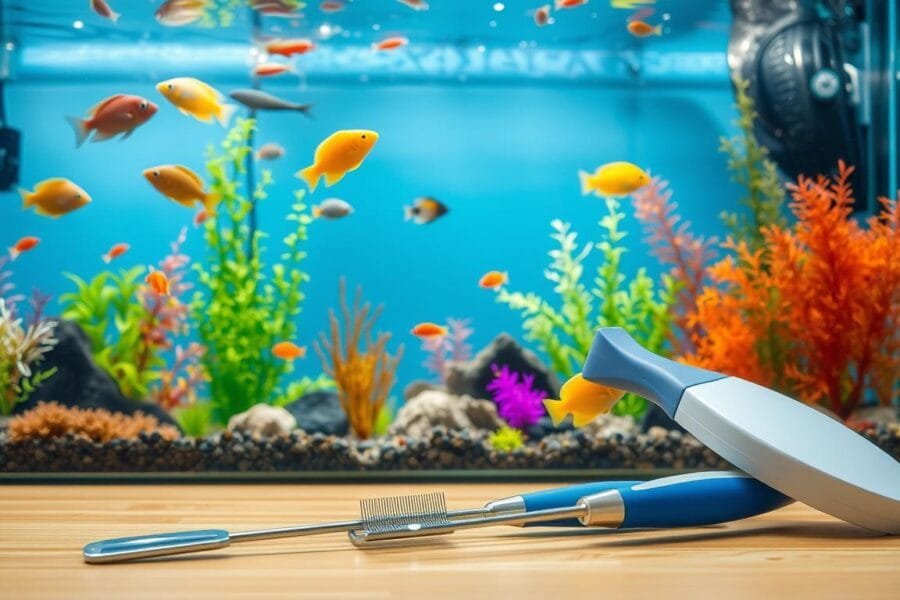Are you unknowingly putting your aquatic friends at risk through neglectful fish tank maintenance? Startling statistics reveal that 90% of aquarium problems stem from poor maintenance practices. This makes regular care critical for your underwater ecosystem.
Regular fish tank maintenance is more than just an occasional chore. It’s a critical lifeline for your aquatic pets. A typical aquarium is a delicate, closed system where waste accumulates quickly. Without proper aquarium cleaning, your fish could be swimming in a toxic environment.
Most aquarium owners underestimate the importance of consistent fish tank upkeep. Surprisingly, 60% of fish deaths are directly linked to imbalanced water conditions. This problem can be easily prevented with routine water changes and proper maintenance.
Maintaining your aquarium isn’t just about aesthetics. It’s about creating a healthy, stable environment that supports the life of your fish. From weekly water changes to regular filter cleaning, each step plays a vital role. It prevents health risks and ensures your aquatic inhabitants thrive.
In this guide, we’ll walk you through everything you need to know about aquarium maintenance routine. You’ll learn how to transform your tank from a hazard to a pristine underwater paradise. This will keep your fish healthy and happy.
Understanding the Basics of Aquarium Care
Creating a thriving aquarium is more than just filling a tank with water and fish. Successful aquarium ecosystem management requires a balance of several key components. These components work together to support aquatic life.
The Role of Water Quality in Fish Health
Water quality is the foundation of a healthy aquarium. Maintaining optimal water parameters is vital for fish survival and well-being. Important water quality factors include:
- pH levels
- Ammonia concentration
- Nitrite and nitrate levels
- Temperature stability
“Clean water is to fish what clean air is to humans – absolutely essential for survival.”
Essential Equipment for Tank Maintenance
Proper tank equipment maintenance is key for a stable environment. Critical equipment includes:
| Equipment | Primary Function | Maintenance Frequency |
|---|---|---|
| Filtration System | Remove waste and toxins | Monthly cleaning |
| Heater | Maintain consistent temperature | Quarterly check |
| Water Test Kit | Monitor water parameters | Bi-weekly testing |
Creating a Balanced Ecosystem
A balanced aquarium ecosystem needs careful management of biological processes. Understanding the nitrogen cycle, managing fish population density, and providing proper filtration are key strategies. These strategies help create a sustainable underwater environment.
By focusing on water quality, investing in proper equipment, and maintaining a balanced ecosystem, aquarium enthusiasts can create a thriving habitat for their aquatic companions.
Regular Fish Tank Maintenance Schedule
Creating a structured aquarium maintenance schedule is key to keeping your fish healthy. It also helps your tank thrive. A well-planned tank maintenance checklist prevents problems and keeps the water stable.
Fish tank owners need a strategic approach to maintenance. Tasks vary in frequency, from quick daily checks to deep cleaning once a month.
Maintenance Frequency Breakdown
| Maintenance Type | Time Required | Key Tasks |
|---|---|---|
| Daily Tank Maintenance | 5-10 minutes | Visual health check, feeding, temperature monitoring |
| Weekly Tank Maintenance | 30-60 minutes | Partial water change, parameter testing, filter inspection |
| Monthly Tank Maintenance | 1-2 hours | Deep cleaning, water testing, equipment check |
“Consistency is key in aquarium maintenance. A regular schedule prevents small issues from becoming major problems.”
- For tanks under 10 gallons, perform a 25% water change weekly
- Well-established tanks might require maintenance every other week
- Check water chemistry the day after water changes
- Clean glass daily or every other day to prevent algae buildup
Experienced fish keepers usually spend less than 2 hours a month on maintenance. The goal is to create a consistent aquarium maintenance schedule that meets your tank’s needs.
Pro tip: Always keep a log of your maintenance activities. This helps track your tank’s health and spot issues early.
Daily Maintenance Tasks for Optimal Fish Health
Keeping your aquarium thriving requires consistent daily attention. Proper fish tank maintenance goes beyond occasional cleaning—it’s about creating a healthy environment for your aquatic friends.

Daily fish tank maintenance isn’t complicated but demands careful observation and systematic checks. Your aquatic ecosystem relies on your consistent care and attention to detail.
Equipment Check Protocol
A thorough aquarium equipment check ensures everything runs smoothly. Here’s what you need to monitor:
- Verify filter functionality
- Check heater performance
- Inspect air pumps and circulation systems
- Ensure all electrical connections are secure
Feeding and Observation Guidelines
Fish feeding requires precision and careful monitoring. Overfeeding can be more dangerous than underfeeding. Follow these guidelines:
- Provide measured portions
- Remove uneaten food within 5 minutes
- Observe fish behavior during feeding
Temperature Monitoring Tips
Aquarium temperature stability is key for fish health. Sudden changes can stress or harm your aquatic pets.
| Fish Type | Ideal Temperature Range | Monitoring Frequency |
|---|---|---|
| Tropical Fish | 75-80°F | Daily |
| Coldwater Fish | 65-72°F | Daily |
| Saltwater Fish | 72-78°F | Daily |
“Consistent daily checks are the secret to a healthy aquarium ecosystem.”
Regular fish health checks can prevent issues before they become serious. By dedicating just a few minutes each day to these tasks, you’ll create a thriving underwater environment for your aquatic companions.
Water Testing and Parameters
Keeping the water quality right is key for a healthy aquarium. Aquarium water test kits are vital for checking important factors that affect fish health.
Water quality is the lifeline of your aquatic environment. Testing regularly stops big problems that could hurt your fish. Bad water can stress, make them sick, and even kill them.
“A clean tank is a healthy tank” – Aquarium Experts
Key Parameters to Monitor
- pH levels
- Ammonia levels
- Nitrite levels
- Nitrate levels
- Water hardness
| Parameter | Ideal Range for Freshwater | Frequency of Testing |
|---|---|---|
| pH | 6.5 – 7.5 | Monthly |
| Ammonia | 0 ppm | Weekly |
| Nitrite | 0 ppm | Weekly |
| Nitrate | Every 2-4 weeks | |
| Water Hardness | 4-8 dGH | Monthly |
When using a water test kit, liquid tests are usually more accurate than strips. Checking the tank regularly during cycling is very important for stable water.
Spotting and fixing water problems early can stop health issues in your fish. Always make small changes to keep the environment stable and healthy for your fish.
Proper Water Change Procedures
Maintaining a healthy aquarium needs careful attention to water change frequency and proper techniques. A well-executed aquarium water change is key for fish health and water quality.
Step-by-Step Water Change Guide
Here are the steps for a successful tank water change:
- Prepare clean equipment for water removal
- Remove about 10-25% of tank water
- Use a gravel vacuum to clean substrate
- Check water temperature before refilling
- Treat new water with aquarium water conditioner
Water Conditioning Methods
Proper water treatments are vital for a safe aquatic environment. Tap water must be treated to remove harmful chemicals that can stress or damage fish.
Water quality is the foundation of a healthy aquarium ecosystem.
Frequency and Volume Recommendations
| Tank Size | Water Change Percentage | Frequency |
|---|---|---|
| Small Freshwater Tank | 10-15% | Weekly |
| Large Freshwater Tank | 20% | Weekly |
| Community Tank | 25% | Every 2 weeks |
Never remove all water during a change, as it can upset the tank’s beneficial bacteria. Always use a water conditioner to neutralize chlorine and protect your aquatic friends.
Filter Maintenance and Cleaning
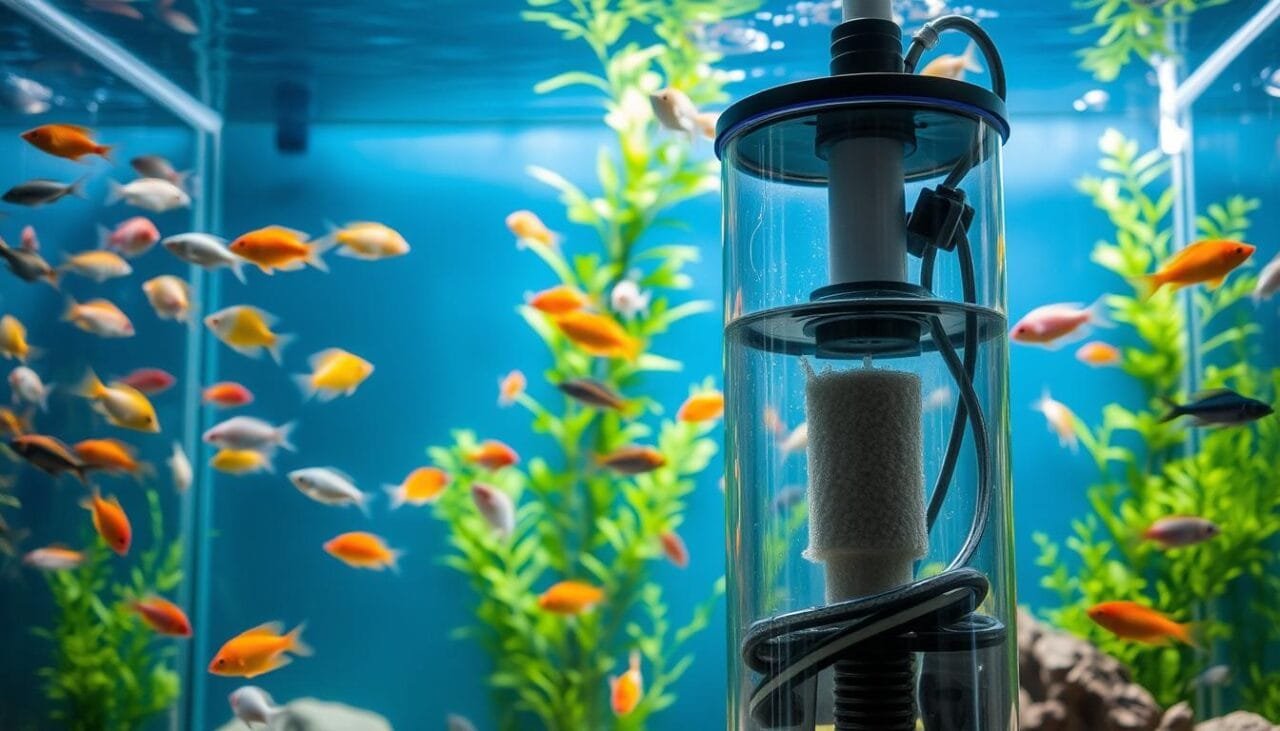
Keeping your aquarium filter in top shape is key to a healthy underwater world. A clean filter keeps the water quality high and keeps your fish safe from toxins. If the filter doesn’t work right, it can let in harmful ammonia and nitrite, which are bad for fish.
Knowing how to take care of your filter means understanding its three main jobs:
- Mechanical filtration: Removes solid particles
- Chemical filtration: Eliminates dissolved contaminants
- Biological filtration: Breaks down harmful waste through beneficial bacteria
How often you need to clean your filter depends on your tank’s size and how many fish you have. Larger tanks with fewer fish need less cleaning than small tanks with lots of fish. It’s a good idea to check the filter’s flow at least once a week to make sure it’s working well.
“Preserving beneficial bacteria is key to successful filter maintenance” – Aquarium Care Professionals
Here are some important tips for keeping your filter in great shape:
- Never clean filter media entirely in tap water
- Replace filter media gradually to maintain bacterial colonies
- Check water flow regularly
- Monitor filter components for any damage
External filters usually need less upkeep than internal ones because they’re bigger and better designed. When you clean them, replace only one-third of the filter media at a time. This helps keep the good bacteria that help with biological filtration.
Watch for signs like a drop in water flow, which could mean the filter is clogged. Fixing these problems quickly helps avoid damage to your equipment and keeps your fish healthy.
Substrate and Decoration Care
Keeping your aquarium clean is more than just changing the water. It’s also about cleaning the substrate and decorations. This helps your fish live in a healthy environment.
Gravel Vacuuming Techniques
An aquarium vacuum is key for cleaning your substrate. It removes debris and waste. Experts say to vacuum one-third of the substrate each time to keep the good bacteria safe.
- Choose the right size aquarium vacuum for your tank
- Begin at one corner and clean methodically
- Use the vacuum gently to pick up waste
- Don’t clean the whole substrate at once
Cleaning Aquarium Decorations
Decorations like rocks and plants can get dirty. This dirt can harm the water and look bad. Clean them with soft brushes and safe cleaning solutions.
Plant Maintenance Tips
Plants need regular care to stay healthy and look good. Trimming them right helps them grow well and get enough light.
| Plant Type | Trimming Frequency | Maintenance Tips |
|---|---|---|
| Foreground Plants | Every 2-4 weeks | Trim to 1-2 inches tall |
| Midground Plants | Monthly | Remove dead or yellowing leaves |
| Background Plants | Every 4-6 weeks | Cut back to prevent overshadowing |
“A well-maintained substrate and carefully curated decorations transform an aquarium from a simple tank to a vibrant underwater world.” – Aquarium Enthuasiast
By following these tips, you’ll make your aquarium a better place for your fish. It will look great too.
Algae Control and Prevention Strategies
Keeping your aquarium water clear is essential for a healthy environment. To control algae, you need a plan that tackles the main causes of growth. Knowing what causes algae blooms helps keep your tank looking great.
Here are some effective ways to remove algae from your tank:
- Limit lighting to 8-10 hours daily
- Manage nutrient levels carefully
- Use an algae scrubber regularly
- Introduce algae-eating fish species
- Conduct routine water changes
Managing nutrients is key to controlling algae. Too much phosphates, nitrates, and iron can cause algae to grow fast. To prevent this, you should:
- Test water parameters weekly
- Use Poly Filters to remove excess minerals
- Maintain a balanced fertilization schedule
“Preventing algae is about creating a balanced ecosystem, not just treating symptoms.”
Natural methods are often the best for controlling algae. Adding fish like Plecos can help manage algae. Also, having a well-planted tank can fight off algae naturally.
If algae keeps coming back, try liquid algae controls like AlgaeFix. It targets algae while improving the tank’s environment. Regular care and watching your tank closely are vital to stop algae blooms and keep your aquarium healthy.
Common Maintenance Mistakes to Avoid
Aquarium maintenance can be tricky. There are several pitfalls that can harm your fish tank. Knowing these common errors helps you keep your tank healthy.
Successful aquarium care needs attention to detail. Avoiding critical mistakes is key to a healthy aquatic environment.
Overfeeding Dangers
Overfeeding is a big tank troubleshooting challenge. Many think more food means happier fish. But, too much food causes water chemistry problems.
- Uneaten food decays, creating toxic waste
- Excess food increases ammonia levels
- Overfeeding can lead to fish obesity
Chemical Balance Errors
Keeping water chemistry right is all about precision. Sudden pH changes or wrong chemical treatments can harm your tank’s ecosystem.
| Chemical Parameter | Safe Range | Potential Consequences |
|---|---|---|
| pH Level | 6.8 – 7.8 | Fish stress, respiratory issues |
| Ammonia | 0 ppm | Toxic to fish, possible death |
| Nitrites | 0 ppm | Impaired oxygen absorption |
Equipment Maintenance Oversights
Ignoring equipment maintenance can lead to big problems. Regular checks prevent failures and keep your tank stable.
“Prevention is always better than cure in aquarium care.” – Professional Aquarist
- Clean filters every 2-3 weeks
- Check equipment for wear and tear
- Replace worn-out components promptly
Following these aquarium maintenance tips helps you avoid common mistakes. This way, you can create a healthy, vibrant home for your fish.
Advanced Maintenance for Planted Tanks
Creating a thriving planted aquarium is more than basic care. Plants need special attention to stay healthy and vibrant. Professional aquarists know that managing tank nutrients is key for plant growth.
Effective maintenance for planted aquariums includes several key strategies:
- Regular plant trimming to control growth
- Strategic aquarium fertilizer application
- Monitoring light and nutrient balance
- Preventing algae development
Plant trimming is vital for keeping plants healthy. Overgrown plants can block light and use too many nutrients, upsetting the tank’s balance.
“Consistent maintenance prevents nutrient accumulation and ensures optimal plant growth.”
Aquarium fertilizer is essential for plant nutrition. Different plants need different nutrients, so targeted fertilization is important.
| Tank Type | Water Change Frequency | Fertilizer Cycle |
|---|---|---|
| High-Tech Planted Tank | 20-25% every 2-3 days | Every 3-4 months |
| Low-Tech Planted Tank | Once per week | Every 6 months |
Proactive maintenance stops problems like algae and nutrient shortages. By knowing your tank’s needs, you can create a lush, healthy underwater world.
Tools and Products for Effective Maintenance
To keep your aquarium in top shape, you need the right tools. Professional aquarium lovers know that good equipment is key. It helps keep fish healthy and the tank lasting longer.
- Water quality test kit for checking all important parameters
- Aquarium siphon for easy water changes
- Algae scraper for cleaning glass and decorations
- Precision thermometer
- Water conditioner
“The right tools turn aquarium maintenance into a fun task.”
Choosing the right equipment is important. Go to a trusted aquarium supply store for top-notch tools. Look for durability, accuracy, and if they fit your tank.
| Tool Category | Key Features | Recommended Frequency |
|---|---|---|
| Water Test Kit | Measures pH, ammonia, nitrites, nitrates | Monthly |
| Aquarium Siphon | Removes debris, performs water changes | Bi-weekly |
| Filter Maintenance Tools | Cleaning brushes, media replacement | Monthly |
Pro tip: Always rinse new tools with dechlorinated water before first use to prevent chemical contamination.
Conclusion
Creating a healthy aquarium needs dedication and regular effort. Regular tank maintenance is key to a thriving aquatic world. Spending 4-6 hours a week can keep your fish in the best conditions.
Aquarium fish care is more than just feeding them. Checking the tank regularly helps spot problems early. Keeping nitrate levels low and changing water often boosts your tank’s health. Goldfish, for example, can live up to 20 years with the right care.
Keeping an aquarium is both hard and rewarding. Each task helps maintain a balance that supports marine life. Whether your tank is small or large, the effort is the same: stay alert, follow routines, and love underwater worlds.
Your aquarium is a living, breathing world that needs your care. By following the tips in this guide, you’ll make a vibrant, healthy space. It will bring joy and peace to your home or office.
FAQ
How often should I perform water changes in my aquarium?
You should change 10-25% of the water weekly. This depends on your tank size, fish number, and filter. For crowded tanks or sensitive fish, change water more often. Always test the water to adjust your schedule.
What are the most important water parameters I need to monitor?
Watch pH levels (6.5-8.2), ammonia (0 ppm), nitrites (0 ppm), nitrates (below 40 ppm), and water hardness. Regular tests prevent health issues and keep your tank stable.
How do I clean my aquarium filter without losing beneficial bacteria?
Clean your filter with tank water to keep bacteria. Rinse media gently in tank water, avoiding tap water or soap. Replace filter media gradually to keep the cycle going.
What causes algae growth in my aquarium?
Algae grows from too many nutrients, bad lighting, and wrong water balance. Overfeeding, too much sunlight, and high nutrients cause algae. Keep your tank clean, control lighting, and balance nutrients to stop algae.
How many fish can I keep in my aquarium?
Fish number depends on tank size and species. A rule is 1 inch of fish per gallon for small fish. But, it changes with fish needs and waste. Always check your fish’s needs and size before stocking.
What’s the best way to introduce new fish to my aquarium?
Introduce new fish slowly through quarantine and acclimation. Float the bag in the tank for 15-20 minutes. Then, add tank water to the bag slowly over 30-45 minutes. Quarantine new fish for 2-4 weeks to avoid disease.
How do I know if my aquarium has a healthy nitrogen cycle?
A healthy cycle has zero ammonia, zero nitrites, and stable nitrates. Use a water test kit to check these. Beneficial bacteria show a good cycle.
What temperature should I maintain in my aquarium?
Most tropical fish like 75-80°F (24-27°C). But, check your fish’s needs. Use a thermometer and keep the temperature steady to avoid stress.
How can I prevent overfeeding my fish?
Feed small amounts that fish eat in 2-3 minutes, 1-2 times daily. Remove uneaten food to avoid pollution. Use automatic feeders or measured portions for consistent feeding. Fish can go days without food, so missed feedings are okay.
What tools do I need for basic aquarium maintenance?
You need a gravel vacuum, water test kit, conditioner, bucket, algae scraper, fish net, thermometer, and siphon. A good kit helps with regular upkeep and keeps your tank healthy.
